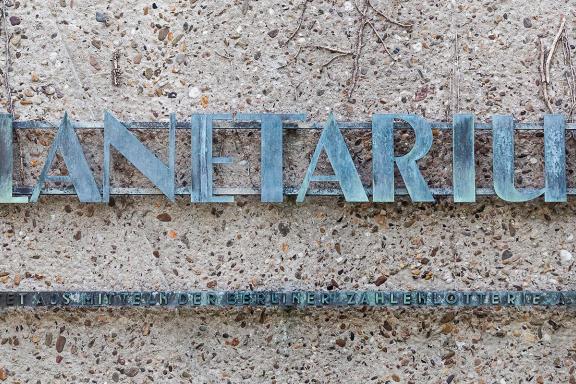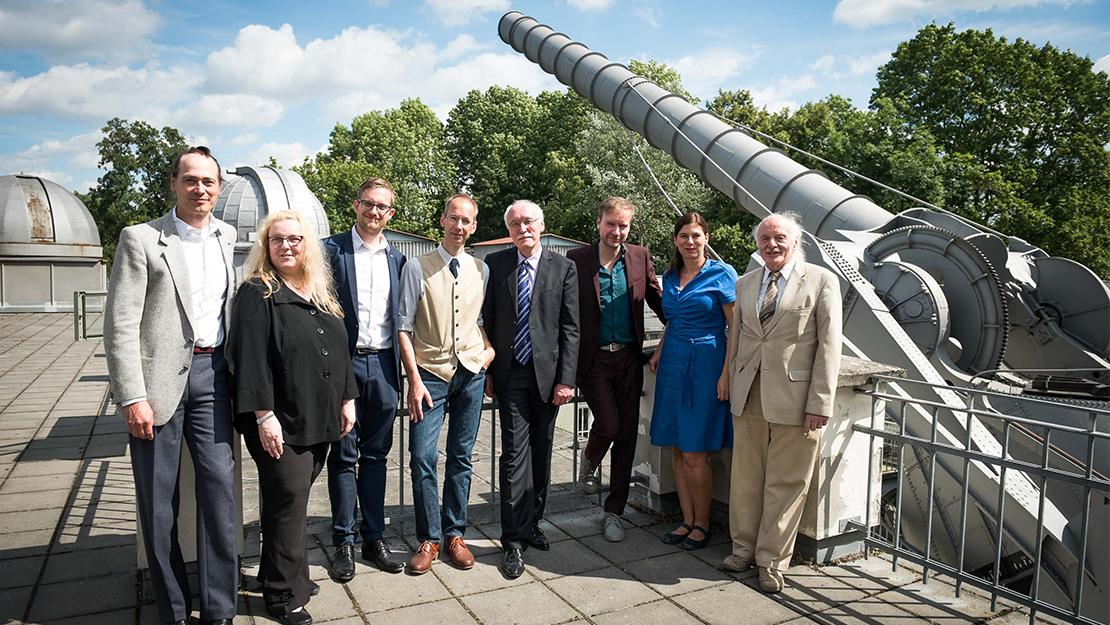
History
Planetarium am Insulaner
History of the Planetarium am Insulaner
1945 – 1947 | Prehistory: The Wilhelm Foerster Institute in Papestraße
As early as 1945, shortly after the end of the Second World War, street astronomers stood in various Berlin squares – astronomy enthusiasts who showed interested passers-by objects in the night sky with homemade telescopes for a few pennies. Two of these »street astronomers«, Hans Rechlin and Hans Mühle, founded the »Wilhelm Foerster Institute« in 1947 in the half-ruin of an officers' mess at Papestraße 2. It was named after Richard Sommer, the former director of the Berlin Planetarium at the Zoo, a student of Wilhelm Foerster. Wilhelm Foerster (1832-1921) was co-founder of the Urania Observatory and director of the Berlin Observatory from 1865-1903.
1950er Jahre | Wilhelm-Foerster-Sternwarte e.V. and handover of the Bamberg Refractor
In 1953 the Wilhelm Foerster Institute is transferred to the Wilhelm-Foerster-Sternwarte Association. On 1 November 1955, the association receives a large refractor as a gift, which is still the main instrument of the observatory on the Insulaner: the 12-inch Bamberg Refractor, which was built in 1889 in the workshop of Carl Bamberg in Berlin-Friedenau. The complete telescope including mount has a weight of 4.5 tons. Depending on air turbulence and observation object, you can zoom between 70x and 700x. Originally, the instrument came from the Urania Observatory on Invalidenstraße. After the destruction of the Urania observatory in World War II, the instrument was salvaged from the rubble, restored and handed over to the association in 1955.
1961 – 1963 | Opening of the Wilhelm-Foerster-Sternwarte am Insulaner
Already in the course of the 1950s it became clear that the rubble site at Papestraße was not suitable for the permanent operation of an observatory. So in autumn 1961 the foundation stone was laid for the new observatory on the Insulaner, a heaped-up mountain of rubble near the Priesterweg S-Bahn station. The new building was financed by the Berlin Lottery. Also in later years, lottery funds provide for investments in technology and infrastructure of the site.
The Zeiss-Ikon-Werke in Berlin donates its no longer needed 11-metre dome from the factory premises on Rheinstraße in Berlin-Friedenau to the new observatory, which is the new home of the large Bamberg Refractor. In addition, a 5-metre dome for the 6-inch refractor and an auditorium with 75 seats are built.
On 30 January 1963, the Wilhelm-Foerster-Sternwarte is opened to great celebrations.
1963 – 1965 | A planetarium is built at the foot of the Insulaner
Already during the construction of the Wilhelm-Foerster-Sternwarte am Insulaner in the early 1960s, there was the idea of building not only a larger teaching building but also a planetarium at the foot of the hill. In Berlin at that time, there was only the small planetarium in the Archenhold-Sternwarte in Berlin-Treptow, which, however, was no longer open to all visitors due to the division of the city. The old planetarium in the Zoological Garden was destroyed during the Second World War and subsequently demolished. With the support of the Schöneberg district and the Senate Department for Education, and once again with funds from the Berlin Lottery, the Zeiss-Planetarium was built according to plans and under the direction of the architect Carl Bassen, who also built the observatory on the Insulaner.
After a construction period of one and a quarter years, the planetarium is ceremoniously inaugurated on 16 June 1965 and opened to the public on 18 June 1965. Since then, 291 visitors have been able to take their seats in comfortable deckchairs under a 20-metre-high dome. In the middle of the hall is a Zeiss Vb star projector that can be lowered into the floor and was manufactured in Oberkochen. In addition to the planetarium hall with foyer, the building also houses a small seminar room and offices.
1989 – 1991 | Building extensions and historical monument status
In the course of an extension of the building, the Astronomical Library was established in 1989.
Since 1991, both the Wilhelm-Foerster-Sternwarte and the Planetarium am Insulaner have been listed buildings with historical monument status.
2003 – 2010 | New projection dome and full dome system
In 2003, the inner dome of the planetarium hall is renovated and in 2010 the planetarium’s technology is upgraded in the form of a 360° full dome system.
2015 | 50 Years of Planetarium am Insulaner
In June 2015, the Planetarium am Insulaner celebrates its 50th birthday with numerous programmes and a commemorative publication.
2016 | Establishment of the Stiftung Planetarium Berlin
Since 1 July 2016, the Planetarium am Insulaner and the Wilhelm-Foerster-Sternwarte have been part of the newly established Stiftung Planetarium Berlin, which unites all of Berlin's astronomical institutions under one roof. Since then, the Wilhelm-Foerster-Sternwarte e.V. association has continued to take on various tasks as a support association.

2023 | Conversion and modernisation of the planetarium
By the summer of 2023, almost 6,000,000 visitors had gazed at the starry sky in the Planetarium am Insulaner. From 9 July 2023 until probably 2026, the planetarium will be converted into a modern education centre as part of extensive renovation and modernisation work, and the technology will be brought up to date. In addition to a new star projector, the planetarium hall will be equipped with modern fulldome technology, LED projectors and a new projection dome, among other things, and the premises will be extended. In accordance with the preservation order, the building will return to its original form with an open entrance area.
